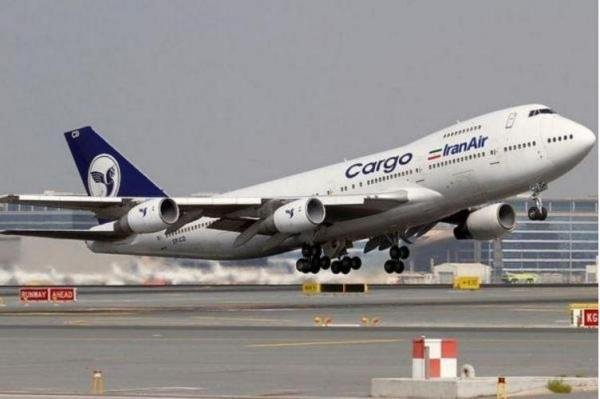One analyst says there are at least five Iranian and two Syrian airlines involved in "regular military airlifts to Syria." Photo by Konstantin von Wedelstaedt/Wikimedia Commons
BEIRUT, Lebanon, May 8 (UPI) -- U.S. officials are eyeing a crackdown on Iranian airlines that allegedly supply arms and equipment to Tehran's allies. The main focus of such a measure would be the air bridge between Iran and Syria that funnels weapons and military equipment to President Bashar al-Assad's military and its Iranian allies, such as Lebanon's Hezbollah, Shia militias in Iraq and Houthi rebels in Yemen.
Hezbollah and the Shia militias have been instrumental in keeping Assad, a long-time Iranian ally, in power almost from the moment the Syrian war began in March 2011. Without these airlifts, most of them through Iraqi air space or overland through Turkey and Iraq, Assad's armed forces and the militias would have had a much harder time surviving.
U.S. President Donald Trump's decision to unleash cruise missiles against one of Assad's air bases on April 7 was the first direct U.S. military intervention against Assad since the war erupted. By American count, the Tomahawk missiles destroyed "one-fifth of the Syrian Air Force's operational aircraft," which Western officials estimated at the time stood at about 260 combat aircraft and helicopters.
That claim has not been substantiated but the unprecedented U.S. operation in Syria does not seem to have amounted to a devastating blow to the regime's military capabilities to wage a savage campaign, which accounts for the overwhelming majority of Syria's 400,000 war dead.
The missile strikes "helped restore America's credibility in the region after years of retreat," observed Emanuele Ottolenghi, an Iran expert with the Washington-based Foundation for Defense of Democracies.
"But if the president wants to really hurt Assad, he should push back against Iran, the strongman's chief protector," Ottolenghi said in an April article for The Hill, a Washington publication. "Disrupting Iran's airlifts to Syria by re-sanctioning its civil aviation sector would be a good place to start."
Iran's badly debilitated aviation sector was included in U.S. sanctions imposed on Iran over its contentious nuclear program. Many of the aviation restrictions were lifted under the July 2015 nuclear agreement between the Islamic Republic and U.S.-led global powers with the proviso that airline services be restricted to "commercial passenger aviation."
But Ottolenghi and other Western analysts insist the Tehran regime and particularly its Islamic Revolutionary Guards Corps have not only continued to covertly airlift troops and weapons to Syria but intensified these operations in recent months.
By Western count there are at least five Iranian and two Syrian airlines involved in "regular military airlifts to Syria," Ottolenghi noted.
The Iranian companies are Iran Air, the Islamic Republic's national carrier; Mahan Air, the country's second-largest airline, which is operated by ex-IRGC officers; Saha Air, linked to the Iranian Air Force; and Qeshm Fars Air and Pouya Air, which are considered to be controlled by the IRGC.
The Syrian carriers are Syrian Air, the national carrier, and Cham Wings, a private airline that flies between Damascus and Tehran.
All these airlines have been flying Iranian arms to Syria, largely through Iraqi airspace, since 2011 when the war began, said Farzin Nadimi, an Arabian Gulf security analyst with the Washington Institute for Near East Policy.
Like Mahan Air, the majority of private Iranian airlines are linked to one degree or other to the IRGC, the most powerful military force in Iran. It runs its own vast economic empire that funds the airlift.
U.S. intelligence officials call Mahan "Quds Air" after the elite al-Quds Force, the corps' special operations wing. It spearheads operations in Syria and other more covert undertakings across the region.
With the easing of economic sanctions on the Islamic Republic, Iran Air and the other Iranian airlines have been seeking new aircraft to boost their airlift capacity.
Iran Air finalized a deal with Boeing to buy 80 aircraft in December 2016 and later signed an agreement to buy 118 jetliners from Airbus.
Iranian authorities estimate that the Islamic Republic will need 400 new aircraft over the next decade.
The Trump administration said on April 5 it was launching a critical review of the sale of Boeing aircraft to Iran, citing the covert military airlifts to Syria and armed Iranian proxies across the Middle East.
If sanctions against Iran were reimposed because of pressure from the U.S. administration, the Boeing and Airbus deals could be nullified. Boeing announced in early April it would sell 30 B737 aircraft to Iran Aseman Airlines, a state-owned enterprise and the third-largest airline in Iran, under a $3 billion deal.
Another Iran Air deal, worth $536 million, with European aircraft maker ATR based in Toulouse, France, for 20 72-600 twin propeller aircraft for internal routes, could also be in jeopardy.
The Aseman sale apparently is allowed under the 2015 agreement but it could founder because Aseman's chief executive is Hossein Alaei, a veteran IRGC commander who fought in the 1980-88 war against Iraq and is still closely tied to the corps. He was chief of the IRGC's naval wing when it clashed with the U.S. Navy during the so-called Tanker War in the Gulf when U.S.-owned ships were targeted.
This article originally appeared at The Arab Weekly.















